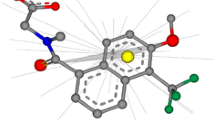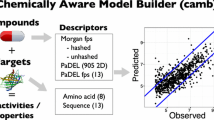Abstract
Quantification of three-dimensional similarity between small molecules is a fundamental tool of rational drug design. However, there are no widely-adopted scoring approaches for comparing whole conformational ensembles between molecules. Such scores would be desirable for scenarios in which properties of a molecule have been measured (e.g. activity against a target) but the relevant three dimensional structure is not known. In this study, a set of three complementary ensemble comparison scores is proposed. These are the maximum similarity between any pair of conformations; the proportion of the whole set of the conformations that are matched to within a threshold 3D similarity score; and the average value over these matched conformations of the molecular shape descriptor ‘σ-fct’, introduced by Ballester et al. The utility of this scoring set is demonstrated in three case studies. The first is an attempt to discriminate between the conformational behaviours of a series of compounds with varying types of cyclisations and other conformationally-significant modifications; the second is an analysis of the more and less active members of a series of GPR119 agonists plus an analysis of a series of orexin-1 antagonists; and the third case study is an attempt to obtain enrichment of active against inactive compounds for a subset of the DUD·E dataset, by ensemble comparison against an active reference compound.







Similar content being viewed by others
References
Shin W-H et al (2015) Three-dimensional compound comparison methods and their application in drug discovery. Molecules 20(7):12841–12862
Ballester PJ, Richards WG (2007) Ultrafast shape recognition to search compound databases for similar molecular shapes. J Comput Chem 28(10):1711–1723
Klabunde T, Giegerich C, Evers A (2012) MARS: computing three-dimensional alignments for multiple ligands using pairwise similarities. J Chem Inf Model 52(8):2022–2030
Cresset BioMolecular Discovery Ltd., Forge. version 10.5.0 (2017)
Dixon SL, Smondyrev AM, Rao SN (2006) PHASE: a novel approach to pharmacophore modeling and 3D database searching. Chem Biol Drug Des 67(5):370–372
Tiberti M et al (2015) ENCORE: Software for Quantitative ensemble comparison. PLoS Comput Biol 11(10):e1004415
Yang S, Salmon L, Al-Hashimi HM (2014) Measuring similarity between dynamic ensembles of biomolecules. Nat Methods 11(5):552–554
Wolfe KC, Chirikjian GS (2012) Quantitative comparison of conformational ensembles. Entropy 14(2):213–232
Lindorff-Larsen K, Ferkinghoff-Borg J (2009) Similarity measures for protein ensembles. PLoS ONE 4(1):e4203
Jahn A et al (2011) 4D Flexible Atom-Pairs: an efficient probabilistic conformational space comparison for ligandbased virtual screening. J Cheminf 3(1):23
Perola E, Charifson PS (2004) Conformational analysis of drug-like molecules bound to proteins: an extensive study of ligand reorganization upon binding. J Med Chem 47(10):2499–2510
Avgy-David HH, Senderowitz H (2015) Toward focusing conformational ensembles on bioactive conformations: a molecular mechanics/quantum mechanics study. J Chem Inf Model 55(10):2154–2167
Habgood M (2017) Bioactive focus in conformational ensembles: a pluralistic approach. J Comput Aided Mol Des 31(12):1073–1083
Sato K et al (2014) Discovery of a novel series of indoline carbamate and indolinylpyrimidine derivatives as potent GPR119 agonists. Bioorg Med Chem 22(5):1649–1666
Coleman PJ et al (2012) Discovery of [(2R,5R)-5-{[(5-fluoropyridin-2-yl)oxy]methyl}-2-methylpiperidin-1-yl][5-methyl-2-(pyrimidin-2-yl)phenyl]methanone (MK-6096): a dual orexin receptor antagonist with potent sleep-promoting properties. ChemMedChem 7(3):415–424
Blundell CD, Nowak T, Watson MJ (2016) Measurement, interpretation and use of free ligand solution conformations in drug discovery. Prog Med Chem 55(Chap 2):45–147
Mysinger MM et al (2012) Directory of useful decoys, enhanced (DUD-E): better ligands and decoys for better benchmarking. J Med Chem 55(14):6582–6594
Cicero DO, Barbato G, Bazzo R (1995) NMR analysis of molecular flexibility in solution: a new method for the study of complex distributions of rapidly exchanging conformations. Application to a 13-residue peptide with an 8-residue loop. J Am Chem Soc 117(3):1027–1033
Blundell CD, Packer MJ, Almond A (2013) Quantification of free ligand conformational preferences by NMR and their relationship to the bioactive conformation. Bioorg Med Chem 21(17):4976–4987
Kirchmair J et al (2006) Comparative performance assessment of the conformational model generators omega and catalyst: a large-scale survey on the retrieval of protein-bound ligand conformations. J Chem Inf Model 46(4):1848–1861
Agrafiotis DK et al (2007) Conformational sampling of bioactive molecules: a comparative study. J Chem Inf Model 47(3):1067–1086
Ebejer J-P, Morris GM, Deane CM (2012) Freely available conformer generation methods: how good are they? J Chem Inf Model 52(5):1146–1158
Chen I-J, Foloppe N (2013) Tackling the conformational sampling of larger flexible compounds and macrocycles in pharmacology and drug discovery. Bioorg Med Chem 21(24):7898–7920
Foloppe N, Chen I-J (2016) Towards understanding the unbound state of drug compounds: implications for the intramolecular reorganization energy upon binding. Bioorg Med Chem 24(10):2159–2189
Hawkins PCD (2017) Conformation generation: the state of the art. J Chem Inf Model 57(8):1747–1756
Labute P (2010) LowModeMD: implicit low-mode velocity filtering applied to conformational search of macrocycles and protein loops. J Chem Inf Model 50(5):792–800
Chemical Computing Group Inc., Molecular Operating Environment, version 2016.08
Wojciechowski M, Lesyng B (2004) Generalized Born model: analysis, refinement and applications to proteins. J Phys Chem B 108(47):18368–18376
Hawkins PCD, Nicholls A (2012) Conformer generation with OMEGA: learning from the data set and the analysis of failures. J Chem Inf Model 52(11):2919–2936
OpenEye Scientific Software Inc., ROCS, version 3.2.1.4 (2015)
Hawkins PCD, Skillman AG, Nicholls A (2007) Comparison of shape-matching and docking as virtual screening tools. J Med Chem 50(1):74–82
ROCS. OpenEye Scientific Software
Knime: Konstanz Information Miner (2016) Knime GmbH
Steinbeck C et al (2006) Recent developments of the chemistry development kit (CDK)—an open-source Java library for chemo- and bioinformatics. Curr Pharm Des 12(17):2111–2120
Beisken S et al (2013) KNIME-CDK: workflow-driven cheminformatics. BMC Bioinform 14(257):1–4
Groom CR et al (2016) The Cambridge structural database. Acta Crystallogr B 72(2):171–179
DUD·E: A database of useful decoys: enhanced. http://dude.docking.org/. Accessed 1 March 2018
Bento AP et al (2014) The ChEMBL bioactivity database: an update. Nucleic Acids Res 32(D1):D1083–D1090
Kruger DM, Evers A (2010) Comparison of structure- and ligand-based virtual screening protocols considering hit list complementarity and enrichment factors. ChemMedChem 5(1):148–158
Nicholls A (2008) What do we know and when do we know it? J Comput Aided Mol Des 22(3–4):239–255
Jain AN, Nicholls A (2008) Recommendations for evaluation of computational methods. J Comput Aided Mol Des 22(3–4):133–139
Acknowledgements
Michelle Southey and Mike Bodkin for comments on the manuscript, and for general computational chemistry insight.
Funding
The author is an employee of Evotec (UK) Ltd.
Author information
Authors and Affiliations
Corresponding author
Electronic supplementary material
Below is the link to the electronic supplementary material.
Rights and permissions
About this article
Cite this article
Habgood, M. Conformational ensemble comparison for small molecules in drug discovery. J Comput Aided Mol Des 32, 841–852 (2018). https://doi.org/10.1007/s10822-018-0132-z
Received:
Accepted:
Published:
Issue Date:
DOI: https://doi.org/10.1007/s10822-018-0132-z




